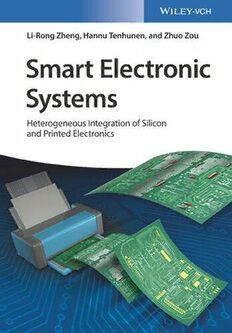Table Of ContentSmartElectronicSystems
Smart Electronic Systems
HeterogeneousIntegrationofSiliconandPrintedElectronics
Li-RongZheng
HannuTenhunen
ZhuoZou
Authors AllbookspublishedbyWiley-VCHare
carefullyproduced.Nevertheless,authors,
Li-RongZheng editors,andpublisherdonotwarrantthe
HannuTenhunen informationcontainedinthesebooks,
ZhuoZou includingthisbook,tobefreeoferrors.
FudanUniversity Readersareadvisedtokeepinmindthat
Shanghai200433 statements,data,illustrations,procedural
China detailsorotheritemsmayinadvertently
beinaccurate.
and
LibraryofCongressCardNo.:
appliedfor
KTHRoyalInstituteofTechnology
16440Kista
Sweden BritishLibraryCataloguing-in-Publication
Data
Acataloguerecordforthisbookis
availablefromtheBritishLibrary.
Bibliographicinformationpublishedby
theDeutscheNationalbibliothek
TheDeutscheNationalbibliothek
liststhispublicationintheDeutsche
Nationalbibliografie;detailedbibliographic
dataareavailableontheInternetat
<http://dnb.d-nb.de>.
©2018Wiley-VCHVerlagGmbH&Co.
KGaA,Boschstr.12,69469Weinheim,
Germany
Allrightsreserved(includingthoseof
translationintootherlanguages).No
partofthisbookmaybereproducedin
anyform–byphotoprinting,microfilm,
oranyothermeans–nortransmitted
ortranslatedintoamachinelanguage
withoutwrittenpermissionfromthe
publishers.Registerednames,trademarks,
etc.usedinthisbook,evenwhennot
specificallymarkedassuch,arenottobe
consideredunprotectedbylaw.
PrintISBN:978-3-527-33895-5
ePDFISBN:978-3-527-69171-5
ePubISBN:978-3-527-69169-2
oBookISBN:978-3-527-69168-5
CoverDesign Formgeber,Mannheim,
Germany
Typesetting SPiGlobal,Chennai,India
PrintingandBinding
Printedonacid-freepaper
10 9 8 7 6 5 4 3 2 1
v
Contents
Preface xi
Acknowledgment xiii
PartI MaterialsandProcessesforPrintedElectronics 1
1 Introduction 3
1.1 ConnectedSmartWorld 3
1.2 SmartElectronicSystems 4
1.3 OverviewoftheBook 6
References 8
2 FunctionalElectronicInks 11
2.1 Introduction 11
2.1.1 PrintingTechnologies 11
2.1.1.1 ScreenPrinting 11
2.1.1.2 GravurePrinting 12
2.1.1.3 FlexographicPrinting 12
2.1.1.4 OffsetPrinting 13
2.1.1.5 InkjetPrinting 13
2.1.1.6 AerosolPrinting 15
2.1.2 FluidRequirementsforInkjetInks 15
2.1.2.1 BoilingPoint 16
2.1.2.2 SurfaceTension 16
2.1.2.3 Viscosity 16
2.1.2.4 ParticleSize 17
2.2 ConductiveInks 17
2.2.1 MetallicNanoparticleInks 17
2.2.2 FunctionalizedMultiwalledCarbonNanotube(f-MWCNT)Inks 20
2.2.2.1 Introduction 20
2.2.2.2 MWCNTInkFormulation 21
2.2.2.3 ResistanceCharacterization 23
2.2.3 MWCNT/PolyanilineCompositeInks 25
2.2.3.1 Introduction 25
vi Contents
2.2.3.2 CompositeSynthesis 26
2.2.3.3 CharacterizationofWater-dispersibleMWCNT/PANI
Composite 28
2.3 SemiconductorInks 33
2.3.1 OrganicSemiconductorInks 33
2.3.2 Single-walledCarbonNanotube(SWCNT)Inks 36
2.3.2.1 SWCNTsinOrganicSolvents 37
2.3.2.2 SWCNTsinWater 38
2.3.2.3 SWCNT/PolymerComposite 39
2.3.3 SWCNT/PolymerCompositesInks 42
2.4 Summary 43
References 43
PartII PrintedElectronicBuildingBlocks 53
3 PrintedThin-filmTransistors(TFTs)andLogicCircuits 55
3.1 Introduction 55
3.1.1 TFTsVersusSiliconMOSFETs 55
3.1.2 State-of-the-artTFTTechnologies 56
3.1.3 NewTFTTechnologies 58
3.2 TFTStructureandOperation 60
3.2.1 TFTArchitectures 60
3.2.2 ElectricalCharacteristicsofTFTs 62
3.2.2.1 CarrierMobility(𝜇) 62
3.2.2.2 On/OffRatio(I /I ) 63
on off
3.2.2.3 ThresholdVoltage(V ) 63
t
3.2.2.4 Sub-thresholdSwing(SS) 64
3.3 PrintedTFTs:anOverview 64
3.4 CarbonNanotube(CNT)-networkTFTs 71
3.4.1 ChallengesinCNT-networkTFTs 71
3.4.2 PercolationTransportinNanotubeNetworks 73
3.4.3 Solution-processFabricationofCNT-TFTs 75
3.4.4 ElectricalPerformanceEnhancementinCNT-TFTs 76
3.4.4.1 HysteresisSuppression 76
3.4.4.2 High𝜇andLargeI /I 79
on off
3.4.4.3 UniformityandScalability 81
3.4.4.4 AmbientandOperationalStabilities 81
3.5 LogicCircuitsBasedonCNT-TFTs 82
3.6 Summary 84
References 85
4 PrintedPassiveWirelessSensors 91
4.1 Introduction 91
4.2 SensingMaterials 92
4.2.1 CarbonNanotube-basedSensors 92
Contents vii
4.2.2 FunctionalizedMultiwalledCarbonNanotubesasHumiditySensing
Material 93
4.2.2.1 HumiditySensingProperties 94
4.2.2.2 HumiditySensingMechanism 96
4.2.2.3 MechanicalFlexibility 98
4.3 PassiveUHFWirelessSensor 99
4.3.1 FlexibleUHFHumiditySensorBasedonCarbonNanotube 99
4.3.1.1 SensorOperationPrinciple 99
4.3.1.2 FlexibleHumiditySensorDemonstration 100
4.3.2 SensorOptimization:InfluenceofResistor-electrodeStructure 101
4.3.3 AnalyticalModelofInterdigitalElectrodeCapacitance 104
4.3.3.1 InterdigitalElectrodeandInterdigitalCapacitance 104
4.3.3.2 ModifiedAnalyticalModelsofIDCs 105
4.4 PassiveUWBWirelessSensor 108
4.4.1 SensorOperationPrinciple 108
4.4.2 TheoreticalAnalysisandData-processingAlgorithm 109
4.4.2.1 TheoreticalAnalysis 109
4.4.2.2 Data-processingAlgorithm 111
4.4.3 SensorPrototype 112
4.4.4 InkjetPrintingofCoplanarWaveguide:VariableInk-layerThickness
Approach 114
4.4.4.1 Introduction 114
4.4.4.2 VariableInk-layerThicknessApproach 115
4.5 Summary 118
References 119
5 PrintedRFIDAntennas 125
5.1 Introduction 125
5.1.1 EvolutionofRFID-enabledUbiquitousSensing 126
5.2 FutureTrendsandChallenges 126
5.2.1 DesignChallengesforRFIDTagAntennas 127
5.3 RFIDAntennas:NarrowBand 127
5.3.1 ProgressiveMeanderLineAntennas 127
5.3.1.1 AntennasDesignEvolutionandGeometry 128
5.3.1.2 AntennaFabricationParameters 131
5.3.1.3 ParametricAnalysis 132
5.4 RFIDAntennas:Wideband 133
5.4.1 BowtieAntenna:RoundedCornerswithT-matching 133
5.4.1.1 AntennaDimensionsandParametricOptimization 133
5.4.1.2 FieldandCircuitConceptsParametricAnalysis 134
5.4.2 BowtieAntenna:SquareHole-matchingTechnique 137
5.4.2.1 AntennaDesignNumericalAnalysisandOptimization 138
5.4.2.2 EffectiveApertureofAntenna 138
5.4.2.3 Results,Discussion,andAnalysis 140
5.5 RFIDAntennas:SensorEnabled 143
5.5.1 ArchimedeanSpiralAntenna 143
5.5.1.1 ManufacturingParametricAnalysis 145
viii Contents
5.5.1.2 ParametricAnalysisofFieldandCircuitConcepts 147
5.5.2 RFIDAntennawithEmbeddedSensorandCalibrationFunctions 149
5.5.2.1 AntennaasaSensorDesign 150
5.6 Summary 152
References 152
6 PrintedChiplessRFIDTags 157
6.1 Introduction 157
6.1.1 RFIDHistory 157
6.1.2 RFIDSystem 158
6.1.3 RFIDAdvantages 161
6.1.4 RFIDApplications 162
6.1.4.1 Logistics 162
6.1.4.2 Healthcare 163
6.1.4.3 Retail 163
6.1.4.4 Manufacturing 163
6.1.4.5 Transportation 163
6.1.4.6 Agriculture 163
6.1.5 RFIDChallenges 164
6.2 Time-domain-basedRFIDTags 166
6.3 Frequency-domain-basedRFIDTags 171
6.4 PrintingofChiplessRFIDTags 172
6.4.1 PrintingofTime-domainRFIDTags 172
6.4.2 PrintingofFrequencyDomainChiplessRFIDTags 175
6.5 Summary 178
6.5.1 LargeCodingCapacity 179
6.5.2 CompactSize 179
6.5.3 Configurability 179
References 180
PartIII SystemIntegrationforPrintedElectronics 183
7 HeterogeneousIntegrationofSiliconandPrinted
Electronics 185
7.1 Introduction 185
7.2 Inkjet-printedInterconnections 186
7.2.1 InkjetPrintingTechnology 186
7.2.2 ElectricalPerformanceandMorphology 188
∘
7.2.3 ReliabilityEvaluationin85 C/85%RHAmbient 191
7.3 HeterogeneousIntegration 192
7.3.1 IntroductionofTraditionalIntegrationApproach 192
7.3.2 HeterogeneousIntegrationProcess 194
7.3.3 ElectricalPerformanceofHeterogeneousInterconnects 198
7.3.4 BendabilityofHeterogeneousInterconnects 200
7.4 Summary 201
References 201
Contents ix
8 IntelligentPackaging:HumiditySensingSystem 205
8.1 Introduction 205
8.2 Plastic-basedHumiditySensorBoxPrototype 207
8.2.1 ArchitectureofHumiditySensorBox 207
8.2.2 f-MWCNT-basedResistiveHumiditySensor 208
8.2.3 SystemIntegration 208
8.3 Paper-basedHumiditySensorCardPrototype 210
8.3.1 FatigueofInterconnectsversusBendingandFolding 211
8.3.1.1 SampleFabricationandExperimentalSetups 211
8.3.1.2 FatigueTestResultsandDiscussion 212
8.3.2 BendabilityoftheHumiditySensor 215
8.3.3 DemonstrationofHumiditySensorCards 217
8.4 Summary 218
References 218
9 WearableHealthcareDevice:Bio-Patch 221
9.1 Introduction 221
9.2 SystemOverview 222
9.2.1 Bio-signals 223
9.2.2 CustomizedBio-sensingChip 225
9.2.3 Inkjet-printedElectrodes 226
9.3 Paper-basedBio-Patch 230
9.4 Polyimide-basedMulti-channelBio-Patch 230
9.5 Polyimide-basedMiniaturizedBio-Patch 234
9.6 Summary 239
References 239
10 LifeCycleAssessment(LCA)forPrintedElectronics 243
10.1 Introduction 243
10.2 AnalysisMethodology 246
10.3 EnvironmentalFootprint 252
10.4 SustainableProductionofPolymer-andPaper-basedRFID
Antennas 258
10.5 Summary 264
References 265
Index 269
xi
Preface
Anuntappedopportunityintherealmofcommunicationandinformationtech-
nologyliesintinysmartdevicesthatwillsoonbeembeddedinalmosteverything
includingpaperandpackaging,thehumanbody,andvariouseverydayobjects.
These smart electronics may sense their environments, process information,
communicate by wireless means, and form ad hoc multihop spontaneous
networks,givingrisetoaworldwide-distributedsystemthatisseveralordersof
magnitudelargerthantoday’sInternet.Thisso-called“Internet-of-Things(IoT)”
willenableawiderangeofapplicationsandprovidenewbusinessopportunities
in many areas including medical and healthcare, safety and security, logistics
and inventory management, manufacturing, and automation. The electronics
as basic devices disappear or are cleverly hidden, but the functionalities are
availableinaubiquitousfashion.
To realize the vision of IoT toward a truly connected smart world, there are
three key enablers for such smart electronics: (i) extremely low-power or even
self-poweredintegratedcircuitsbasedonadvancedcomplementarymetal-oxide
semiconductor (CMOS) technology for computing, communication, sensing,
andperception;(ii)flexibleandlargeareaelectronics(LAEs)formultifunction-
ality and interfacing to the analogy world; and (iii) hybrid system integration
technologiesthatintegrateconventionalsilicon-basedCMOSchipswithprinted
materials/devices on flexible substrates. As silicon chip is inexpensive as mea-
suredbyperfunctionwhereasprintedelectronicsischeapasmeasuredbyper
area,webelievethatthehybridintegratedsolutionofsiliconchipsandLAEswill
bethemostpromisingsolutionforfuturesmartelectronicssystems.Thisbook
covers various aspects of smart electronic systems and summarizes our recent
researchfrommaterials,devices,systemstoapplications,withspecialfocuson
LAEsusingprintingtechniquesandintegrationtechnologiesforhybridflexible
systems.

